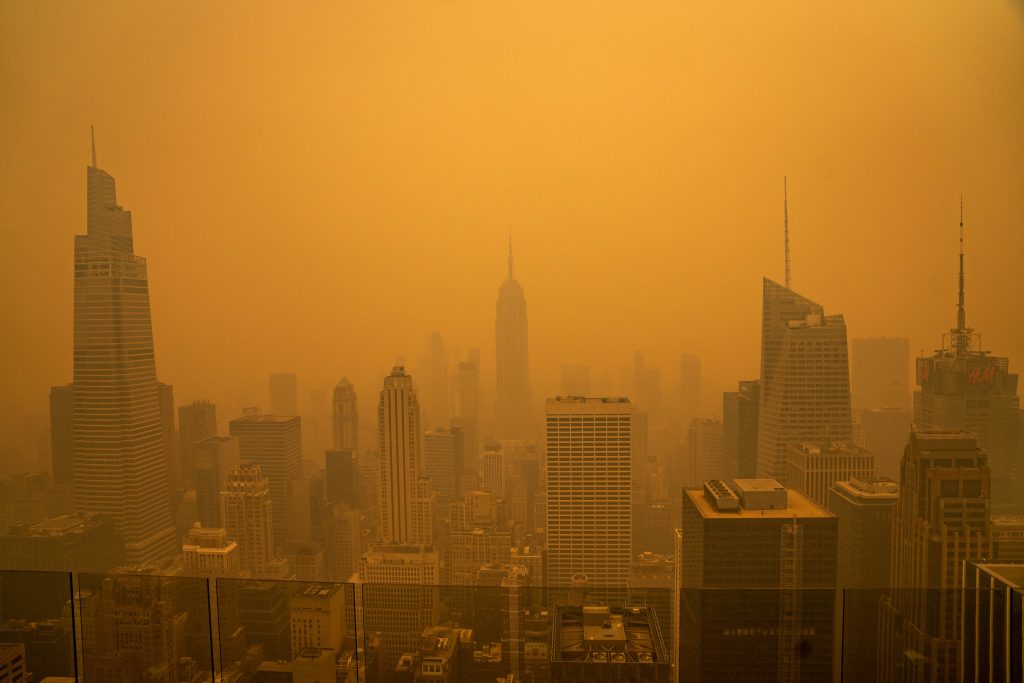I recently read an essay by Claire Cameron discussing why mismanaged forestation efforts often do more harm than good, and it resonated with me a lot. This post is a summary of what I drew from the article, and what I think can be done to improve our reforestation efforts.
The problem
You might remember seeing this last year:

The cause of that air pollution was wildfires in Canada, fueled by climate change, and thriving in the densely packed forests of Ontario. Curiously, many of the forests that burned in 2023 were planted by humans.
Cameron writes,
“As I watched the sun burn a hole in the horizon, I had an additional realization: Thirty years ago, I did something that probably helped fill the sky with smoke”
That “thing” was planting black spruce trees in Ontario. Black spruce trees are notorious for being flammable – their cones are filled with oily sap, they dry easily and quickly under shade, and planted densely together in a monoculture, they are a recipe for wildfire.
This brings us to the core of the issue.
Planting trees has become synonymous with helping the environment in a tangible way – companies use it as a way to cement environmental commitments, charities spend on afforestation.
But when timber companies create plantations with fast-growing and fast-burning coniferous trees, the environmental benefit of reforestation goes to zero. Today, with exacerbating climate change and a greater pressure to go green, it’s more important than ever to consider the impacts of tree plantations.
The environmental equation
“When a measure becomes a target, it ceases to be a good measure.”
Goodhart’s Law
The process of clear-cutting, which removed a diverse array of slow-growing and flame-resistant trees, combined with the uniquely flammable anatomy of the black spruce, has led to increasingly catastrophic wildfire seasons over the past few decades in Canada.
It gets worse.
Growing trees can mean tearing open existing ecosystems, uprooting habitats and soil. Soil in particular sequesters 80% of all total terrestrial CO2.
Because of these issues, Canada’s forests have become carbon sources, releasing more carbon into the atmosphere than they are accumulating in any given year’
But this problem isn’t unique to Canada. Even in countries where wildfires are less common, such as tropical Borneo, deforestation wreaks havoc on the environment.
Industrial plantations are dangerous to the environment because the fertile lands on which they farm are also the most ecologically important. Famously, palm oil plantations are responsible for some of the worst deforestation worldwide.
The psychological issue
“The dangerous mistake we were making gets to the heart of what people often get wrong about environmental stewardship: the notion that, no matter how rapacious or careless we are, we can always dig or plant our way out through sweat, pluck and industry.”
Claire Cameron
You know who plants trees all the time? Companies aiming to improve their perception among eco-friendly consumers.
Plant a forest to save the environment, or better, outsource it to a forestry company that will cut down real forests to produce cash crops. Worse, plant on top of a grassland and destroy the local ecosystem, doing net harm to the environment.
Companies get away with it because people equate planted trees to a better environment.
Similarly, we equate cutting trees to be bad for the environment, and while the vast majority of logging operations do not cut trees ecologically, that isn’t to say that there aren’t environmentally friendly ways to do logging.
In particular, logging is only harmful when it displaces habitats. They’re essential to sequestering CO2 – trees that are cut don’t rot and release CO2. Done sustainably (see retention shelterwood systems), silviculture can actually help an environment instead of hurting it.
This comes to another crucial point about environmental stewardship. No figure like the number of trees planted can serve as a true proxy for improving ecosystems. At the end of the day, we cannot let figures that are easy to market outweigh the very real impact on nature.
Questions and Potential Solutions
Mindless creation is just as bad as mindless destruction – Canada saw this last year, and more countries will experience it firsthand in the coming years.
Thus I call local and national governments to do the following:
- Establish funding for climate change related disasters
- Provide additional funding for wildfire prevention and prescribed burns
- In particular, Ontario’s wildfire prevention is severely underfunded.
- Create and enforce legislation discouraging monocultures
I’d also like to ask the following questions:
What role do plantations have in promoting tree planting? Do they use the labor of the environmentally conscious for their own profit?
What tools can be built to help ecologically conscious donors trace their money to monocultures?
How can we identify and prevent misconceptions about the climate? How do we make climate discussions nuanced?
If trees can’t solve our climate issue, should governments invest in carbon sinks?
Tree farms are aware of the dangers of planting without regard for the environment. Are they not liable for their actions?
